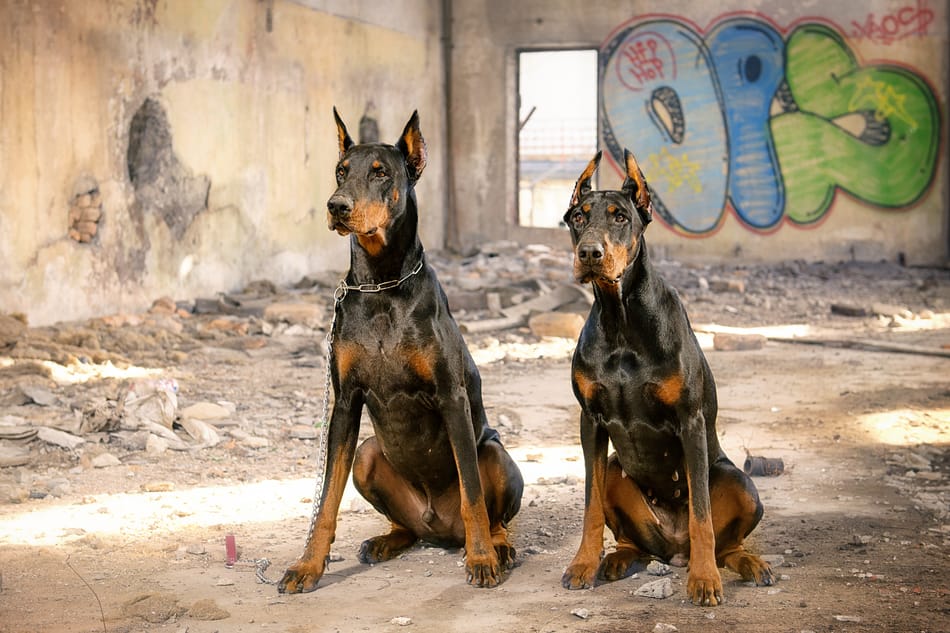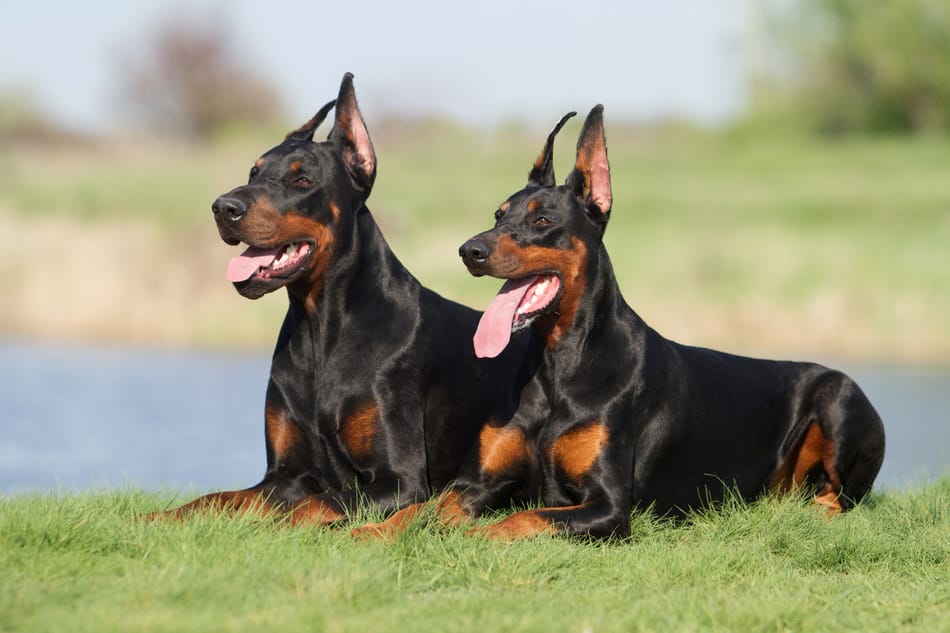
Although both male and female Dobermans make excellent family pets, there are some significant differences between the two. Knowing these differences will help you decide which one would be the best fit for you. Deciding if you want a male or female Doberman is one of the first important steps to getting a new puppy. Remember, it’s not just about which sex “is the best” it’s about which “is the best fit” for you and your home environment.
Should I get a male or female Doberman? If you want a Doberman that’s easily housebroken, quick to train, sticks close by your side in public, and gentle around kids, then you may want to get a female. If you want a Doberman who’s more playful, social, and likely to bond equally to all family members, then you may want a male Doberman.
I wrote this article to address the differences between male and female American Doberman Pinschers for those considering getting a Doberman. There is a lot to this topic, and it’s not as simple as you might think. So let’s get into detail and see what makes male and females tick in their own way.

Male Dobermans
Overview
Height: 26 – 28 inches
Weight: 75 – 100 lbs
Puppy Price: $1500 – $2500
Lifespan: 10 – 13 Years
Build: Bulkier with more muscle mass.
Temperament
- Alert, loyal, loving, and protective.
- Matures slower – usually by age 4.
- Harder to train when young.
- Slightly more desire to please his owner.
- More social with new animals and people.
- Less suspicious of strangers.
- More demanding of attention.
- Less needy of affection to be happy.
- Less likely to stay close off-leash.
- Less serious/intense.
- More playful and goofy.
- Can be clumsy around kids.
- A bit more stubborn.
- Can be messier overall.
- More hyper during puppy years.
- Less in-tune with owner’s emotions.
- More likely to bond with all family members equally.
- Less likely to get along with other dogs at the dog park.
- Excels as protecting a territory or whole family.

Female Dobermans
Overview
Height: 24 – 26 inches
Weight: 60 – 90 lbs
Puppy Price: $1500 – $2500
Lifespan: 10 – 13 Years
Build: Slimmer with less muscle mass.
Temperament
- Alert, loyal, loving, and protective.
- Matures quicker – usually by age 2.
- Easier to train when young.
- Slightly less desire to please her owner.
- Less social with new animals and people.
- More suspicious of strangers.
- Less demanding of attention.
- More needy of affection to be happy.
- More likely to stay close off-leash.
- More serious/intense.
- Can be a little less playful.
- Gentler/more cautious around kids.
- Less stubborn.
- Cleaner overall.
- Less hyper during puppy years.
- More in-tune with owner’s emotions.
- More likely to bond with one person in the family.
- More likely to get along with other dogs at the dog park.
- Excels as protecting an individual.
Doberman Buyer’s Guide: Take a look at my guide for selecting the right type of Doberman (here) which will walk you through how to select the best type of Doberman for your specific situation!
Physical Differences
Males
Males are very similar looking to females at first glance but there are definitely some differences. These differences are more apparent in person than in pictures. Males are about 2 inches taller on average and 15 to 20 pounds heavier. So they are larger dogs overall. They also have more muscle mass so they appear a bit bulkier with hard angles on their body when compared to females.
Females
Female Dobermans are smaller in size overall than their male counterparts. They are about 2 inches shorter and average 15 to 20 pounds lighter than males. Females are smoother looking and some say more elegant in appearance.
Temperamental Differences
Males
Male Dobermans are said to be a little goofier and playful. They tend to calm down around the age of 4 years old (whereas females usually calm down around the age of 2). Many Doberman owners prefer males though due to their fun-loving and laid back nature when compared to females. They’re more tolerant of strangers in public and quicker to run and play with someone new than a female Doberman. They’re also eager to please and excited for whatever the next task is that you might ask of them.
The male’s carefree attitude also means they can be a bit messier than females at times (tracking in mud, letting water drool out of their mouth after drinking, etc) and a little more clumsy. This can be scary at times, especially if you have young kids around and they get overly excited.
TIP:
A neutered male Doberman will be a lot calmer as an adult, and less likely to have aggression issues.
Testosterone is great for building muscle and when you’re protecting your territory from other male invaders, but it can affect temperament also. Males can be a bit more headstrong and need clear, firm, direction from their owners. They can also be a bit more pushy about getting attention when they want it and some say they are much more “on top of you” throughout the day than females are.
All Dobermans are amazing guardians and protectors. Males are more likely to bond with the family as a whole pack and be more protective over their home and property. Whereas females tend to focus more on protecting one specific person whom they’ve bonded with. For this reason, they also like to mark their territory by peeing everywhere quite often.
Females
Many Doberman owners who have both female and male Dobies will tell you that the females are more serious and intense in everything they do. They’ll mature quicker and be easier to housebreak and train early on because of this. Female Dobermans tend to start “acting like adults” at around the age of 2—about half the time of a male Doberman. That means they can be trusted to be home alone earlier than males. Many say a female Doberman is easier to own for a first-time owner.
Females will be less tolerant of strangers in public, which can be a good or bad thing depending on the situation. They are less social with new people or dogs they don’t know. This can mean they might take a little longer to warm up at the dog park. They don’t have issues with same-sex aggression like males do when in a casual setting like a dog park, although this is a different story when two female dogs live together in the same house.
They’re also a bit cleaner than males—they’ll make sure they’re completely done drinking from their water bowl before they run off around the house with water and drool dripping from their mouth, which is a really great thing.
Females also love to cuddle and be close to their owners like the males, but they also know how to give you occasional space when it’s needed. They’re more in-tune with your emotions than males are and will behave accordingly. There is a reputation for female Dobermans to be a bit more “moody” and emotional than their male counterparts. They can also be trained with a bit softer direction and guidance than a male due to how well they maintain focus.
Trainability
Males
Males are a little more playful and even “goofy” at a young age, which means that it can be harder to keep their attention when they’re young. This, of course, has an impact on training time. So you may find yourself struggling to keep your dog’s attention while teaching him something new when he’s young. For these reasons, males are generally considered to be a bit harder to housebreak and train when they’re younger. After about the age of four, they’ll calm down considerably and start acting a bit more mature.
Because males tend to be more social and playful, they get distracted easier when walking off-leash. Although most first time Doberman owners won’t even notice this as an issue since Dobermans, in general, excel at being off-leash, especially when compared to other breeds.
Males are also eager to please their owners and are excited for the next task that is given to them. They have all the drive and desire to do what you’re asking of them, but sometimes they are just too happy and carefree to focus in on it.
Females
Female Dobermans are described as more intense, serious, and focused than males. They mature quicker—usually maturing in attitude by around age two, whereas males don’t mature until about age four. This means that you can potty train a female, trust her to be alone, and generally be successful with more in-depth training earlier in her life.
Since females are harder to distract than males, they tend to do better with off-leash training. However, they tend to be less eager to please or “complete the next task” asked of them by their owners.
Female Dobermans are more in tune with their owner’s emotions and therefore respond better to light correction and praise during training than males. Any Doberman will be easy to train compared to other breeds, but females seem to excel at it.

Health Differences
Males
Unfortunately, males can be more prone to bone, joint, and hip problems than females. This is likely due to their extra weight and size. Some owners suggest that they also have slightly shorter lifespans. This would make sense since traditionally, the larger a dog is the more strain is placed on their heart and the shorter their life span is. You should always DNA health test your Doberman.
There was a study published in the Journal of the American Veterinary Medical Association that appears to confirm that male Dobermans are more prone to developing dilated cardiomyopathy (DCM), a deadly heart condition prevalent in Dobermans, at some point in their lifetime than females (source).
I haven’t noticed a correlation between sex and lifespan in my experience so far. So for now, the lifespan expectancy will remain listed as the same between males and females on this site until I see a reputable study showing otherwise.
Females
Being lighter and smaller is certainly a little easier on the body, this makes them a bit less prone to bone, joint, and hip problems than males. Some suggest they live longer than their male counterparts due to no having the strain of a large bulky body on the heart. They also are less likely to develop dilated cardiomyopathy (DCM) during their lifetime than males. However, most owners report similar life spans between males and females. You should always DNA health test your female Doberman also.
Males and females seem to be equally prone to the other major diseases that affect the Doberman breed including bloat, hepatitis, von Willebrand’s Disease, wobbler syndrome, and other issues
For more about the lifespan of the Doberman pinscher, including the results of a poll of many long-time Doberman owners regarding how long their dogs actually lived, see my article What’s the Actual Lifespan of a Doberman Pinscher? In that article, I also talk about the oldest known Doberman Pinscher, which lived to a surprisingly old age!
Doberman DNA Health Testing – A simple cheek swab you can do at home can spot the signs of a majority of the genetic issues that plague the Doberman breed. I made this simple DNA Health Testing Guide to help you do this at home yourself. Every Doberman owner should be doing this, I really can’t urge it enough considering the diseases plaguing this breed.
With Children
Males
Since males tend to be more goofy and carefree, they also sometimes are a bit more clumsy. This can be an issue when they grow to be close to 100 pounds in size and you have a small child at home. Male Dobermans love to run, bounce, and play and are a bit more hyper overall than females until about the age of four.
Accidental injuries because your Doberman knocked over, or rolled over, you kid can be just as serious at times as injuries due to an overly aggressive dog. Other than accidental injuries, there are not really any other risks with male dogs around children. They are generally great with kids otherwise.
Male Dobermans are extremely fun-loving dogs that want to play just about as long as your kids will tolerate them. This is great if you have children who could benefit from a dog who will wear them out and “go until they drop”.
Females
Since females mature quicker and tend to be a bit more serious than their male counterparts, they are more cautious around very young children. This can be a really great thing when you have young children in the house since accidental injuries may be less likely to occur.
However, they are more likely to bond strongly to one specific person in the house, and this will usually be a child. Whereas males will bond more evenly to all members of the household. This means the female may become pushy about sleeping in the room with their favorite kid, for example. However, if you want help bonding with a Doberman that may have become attached to someone else, see this guide on how to bond with a Doberman.
Females will still love to run and play with kids but are less likely to “go all day” with the fun and games like a male will. They will need to get their space at times when the kids become too much.
For more about what you can expect with a Doberman in a house with children, see my article Are Dobermans Good with Kids? What You Need to Know.
With Other Dogs
Males
With other dogs, however, males can be a bit more likely to get into conflicts to determine dominance. Although they usually stop fighting at that point whereas females will often get in much more serious fights. Either way, the best bet is to have a male Doberman live in a house with a female dog and not another male. If you must have more than one male in the house, make sure they’re neutered, this will help avoid same-sex aggression issues. Also, put extra focus on socialization, when they’re young, is important to counteract this.
Overall though, the male’s outgoing and playful nature does generally make them more social with other animals. So they’re more likely to run off and play with new dogs than a female is.
They’re also more protective of their territory than females are. So if you unexpectedly have a previously unknown male dog showing up on your property, there could be problems. However, male Dobermans do tend to get along with females dogs of all breeds.
Females
Although they’re a bit more cautious with new dogs they meet for the first time, like during a trip to the dog park, they’re also less likely to get into dominance confrontations with another dog. It may be tough though getting your female Dobie to leave your side and run off to play with other dogs.
You’re less likely to have alpha dog issues with a female. They are, of course, much more likely to get along better with a male dog in the house than with another female. Same-sex aggression between females does exist and some say it’s just as common, or more so, than male on male aggression.
A study published in the Journal of the American Veterinary Medical Association showed that 79% of aggression issues between two dogs in the same house involved same-sex dogs, and 68% of those involved females (source). The difference seems to be in the severity of conflicts. In general, males will stop fighting when dominance is determined whereas females will fight until they severely injure (or worse) the other female.
If you must have two female dogs in the house, try to make sure there is at least a two year age gap between them (but the more the better). This will help increase the chances of them getting along.
Which is better for a family?
This is a difficult question to answer and there really isn’t any right or wrong answer. Both male and female dogs do extremely well in a family environment. They both love being close to people and being a part of a “pack” (or family unit). Really, it’s whichever dog better fits your lifestyle.
A female does better in family environments where small children or a male dog are present. However, every circumstance and every dog is different. So it really goes a little deeper than that. Below are the potential advantages each dog can have in a family environment.
Advantages of Male Dobermans in a Family Environment:
- Can “play all day” with children.
- Love endless outings—great for active families.
- Will get along well with female dogs in the house.
- More social and easy-going with new people or animals.
- Usually bond equally to all members of the family.
Advantages of Female Dobermans in a Family Environment:
- More cautious around young children.
- Easier to train at an earlier age.
- Less hyper during the puppy years.
- More protective when in public—less trusting of strangers.
- Will get along well with male dogs in the house.
- Usually bond tightly to one specific family member.
If you have a dog already in your family, it might be best to get a dog of the opposite sex. If you must get a dog of the same sex, make sure the dogs are fixed and there is a good age gap between the two (at least 2 years, but more is better). If possible, owning two dogs of the opposite sex is best.
If you have children in the house males are goofier, fun-loving, and “play all day” type of dogs which might be great for older school-aged children if you need someone to wear them out during the day. It’s also great if you have an active lifestyle and want a dog that’ll join you on endless outings. Females are gentler and less clumsy which is great around infants and toddlers.
Whichever sex you choose, focus on socializing them as much as possible early on in life. If you do that, I don’t think you can make a wrong choice here. If they are well socialized, any Doberman will do great in a family. So never miss an opportunity to bring them to a family gathering or around new people or animals. You’ll have a loyal, loving, gentle, family Doberman when he or she is grown up.
Which is a better guard dog?
This is another tough question to answer. First off, any Doberman is an amazing guard dog—this is what they were originally bred for. The reason this is so hard to answer is that their ability to excel in guard work depends far more heavily on their training, environment, and individual temperament than what sex they are.
It will also depend heavily on what type of guard work you’ll be using them for. But for a minute, let’s dissect this topic as much as possible and discuss this by taking into account all the known differences between the two sexes when it comes to guard work. The following aspects are points that can make each dog superior in protection work, depending on the circumstance.
Advantages of Male Doberman Guard Dogs:
- Larger with more muscle and strength.
- A stronger bite.
- Better at protecting an entire territory or home.
- More inclined to protect an area or person from other dogs.
Advantages of Female Doberman Guard Dogs:
- Mature quicker and therefore can start guard work earlier.
- More suspicious of strangers.
- More agile.
- Better at protecting one specific person.
- Not as territorial about their home or property.
It really depends on what you want your dog to do for you as far as protection goes. If, for example, you are looking for a dog to be more territorial and protect your whole property, a male Doberman might be the best bet. However, if you want more of a personal protection dog that is inclined to protect one specific person in the family, and who might give the mailman a break when he approaches the house, a female might be best.
Females tend to be seen as better personal protection dogs while males are better overall guard dogs. Personal protection means you’re protecting one specific person and guard work means you’re guarding a whole territory, family, or property. Females will often bond tightly to one specific person in the house whereas a male will be more likely to bond to everyone in the family equally.
For the even more about the differences between males and females when it comes to guard work, see my article Are Male or Female Dobermans Better Guard Dogs?
Final Thoughts
The best part about writing this article is simply that I don’t think I can steer you wrong. Dobermans, in general, are very adaptable dogs with a little bit of work and a whole lot of socialization when they’re young. So no matter if you pick a male or female Doberman, as long as you socialize them properly, and put a little effort in, I think you’ll be happy with your choice.
In this article, I dissected all the sometimes very subtle differences between males and females. But keep in mind that these differences are quite small. More than what sex you choose, the biggest factor is the individual dog’s temperament, their environment, past experiences, and what you’ve done as an owner prepare them to display acceptable behavior.
Now that you’ve hopefully decided whether a male or female Doberman is best for you, what about deciding between a European and American Doberman? To learn about European Dobermans and how they compare with American Dobermans, see the article I wrote about the differences between American and European Dobermans here.



Great article, I’ve read quite a few of yours recently with each being well written and so informative.
I was wondering if this breed would do well in the Arizona, dry desert?
We like morning walks and enjoy hiking, but don’t want the dog to suffer in that hot sun all summer.
I look forward to hearing from you.
Dobermans have a single layer coat which you’d think would be better for the heat but in reality, it can be worse in a lot of ways. The heat transfers almost directly to their skin. They’re also muscular dogs so they do tend to overheat easily. They aren’t great in the heat. I wouldn’t say they can’t work in a desert environment by any means, you just need to focus a bit more on keeping them cool. They’re indoor dogs anyway primarily so they should be in your air-conditioned house most of the time anyway.
Hi! I currently have two neutered, male Labrador mixes in my house. I will be adding a European Doberman puppy to my home this summer. I was wondering what you think about a male or a female? Both my dogs are pretty mellow, and are over 2 years of age. One being nearly 13 years. I’m not looking for a guard dog, just a dobie with a great all-around temperament, whose obedient and great with dogs and people.
Any advice would be great! Thanks!
Hi Erika! Generally, you’d be a bit safer getting a female Doberman in your situation. This is because same sex aggression in male Dobermans can be an issue. Getting a female would probably help to keep things calm at your house. The only issue could be with the female’s first heat. It could cause aggression with your two boys. But that depends a lot on the individual dog. Also if you got your female spayed before then it also won’t be an issue.
I am planning to become a first time Doberman owner, but I am still struggling with what sex to get. I am a young single woman living in an apartment. In general, I’ve always been told that it was better to get the opposite sex dog ( not sure if that’s true) and I have always wanted to get a male dog. I like the idea of them being more playful but I really like the idea of the female being protective of one person and staying close to their owner. As, its only me, I really want a dog that will make me feel safe and like they’re always watching me and have my back. I also noticed you mentioned that females are a bit easier for first time owners. I’m just nervous about the female maturing so fast and being super moody/serious. I’m really stuck in my decision. Like I mentioned I always planned to get a boy but now I think maybe I should get a girl. Thoughts? Thanks!
Hi Elle! Really their differences can be quite subtle and a bigger impact on their behaviors is how you raise them and their individual genetics/temperament. Dobermans, in general, are GREAT personal protection dogs. So even if the female might be slightly more “single-person inclined” as far as bonding goes, really even the male will bond quite closely. Especially if they are in a family of one so to speak. Yes, females can be moody at times. If you want a male I certainly wouldn’t hesitate because of the bonding behavior differences. Both are Dobermans and both will bond extremely tightly to you. A male Dobie will definitely always have your back if things got serious. Good luck with whatever you choose! Focus more on the individual pup you pick than what sex they are!
This was a good read and enjoyed it. I am curious about other house pets though? We have chickens outside, and a rabbit that lives in side and sometimes goes out in the day time and an inside parakeet. I have thought about getting a Doberman. Would like one that can be left alone outside with the chickens without worrying about going outside seeing my flock dead
Hi there!
I am looking into owning my first dog, which I want a doberman to be, and probably will go with the female.
My question is how easy is it to train the female Doberman to be a good guard dog for my house while I’m not home and still be a loving animal towards other humans and my 7 year old son?
Dobermans, in general, are great guard dogs naturally. In most situations, you don’t even really need to train them and very often their presence alone is enough to deter any would-be intruders. I am a big believer that if you just focus on making your Doberman a well-rounded, confident, dog who is loving and well socialized, then you’ll have a great family dog who will also naturally protect the family. If you want to get serious about guard and protection training you could look into IPO training or something similar. Females will do great at this as will males.
I’m in the process of buying a male European Dobie and have a neutered 4 year old male mix breed already in the house. I don’t plan on neutering the Doberman. Should I expect problems?
Hi Doug! Potentially, the one thing you have working in your favor though is the age gap and the fact that you’ll be getting a puppy who will be growing up with the other dog in the house the whole time. Just be careful around puberty time (about the 6 months to 2 years old time frame). If you want the best chances of success, consider getting a female puppy. If not, you can still make it work with two males, you just need to be very cautious as same-sex aggression can be an issue in Dobermans.
I’m considering adopting a male 19 month-old male Doberman from a breeder who had the dog returned. It sounds like the family who bought the dog was unable to train or work with the dog the first year. They also sounded very distracted by a family tragedy that had occurred prior to purchasing their Doberman. The breeder now has the dog at 19 months and old, and we’re considering adopting the dog. We are empty-nesters with grown and gone children. I’m retired and have lots of time for personal training and classes. My only concern is that the dog not being able to bond with us. He’s still young which is good. We’ve had a German Shepard and other breeds in our lives. Have you ever known a male dog being rehomed at 19 months-old who did great with new owners. Or is their too much to question in the pups background? Thanks.
Hi Wendy, I’ve definitely known Dobermans 19-months old (and much older) who have been successfully rehomed. Being that it’s a male Doberman might really help you here since males are usually a bit more accepting of strangers. This might help you warm the dog up to your home quicker. The uncertainty of what they went through in the past is certainly an issue. But my biggest caution I give to people there is if they have young kids in the house (for safety reasons). You don’t have that issue, so that’s a major plus. If you can adopt and are willing to take that on, I’d definitely do it! Such a great thing to do for the breed!
I’m fostering a Doberman rescue dog who was removed from a home along with several other dogs. I’ve had her for 3 days now and she’s already gotten very attached to me so I am concerned. I want her to get adopted as soon as possible because of this but I want to make sure she gets placed with the right sort of owners. Any suggestions?
That’s definitely pretty typical of a female Doberman. That’s so great that you’re doing that for her! I’d say to continue being loving, but set limits. Let the new owners flood her with all the love possible, not so much you. It might help her to remain just the slightest bit reserved with you and hopefully open up to the new owners more. Sleeping is a great example. Personally I’d not let her sleep with you since that’s a major bond-builder with dogs. Also not letting her on the couch and fall asleep with you might be beneficial. You can still give her a very comfy dog bed, lots of love, but the most subtle of limits might make the difference for the new owners. Or it won’t matter, but I’d say it would be worth a try to help her as much as possible. Or you could adopt her yourself! Even better! Haha.
my mom loves dobermans but i have 2 other dogs that is the only reason she is hesitant because 1 of my dogs is old and my other isn’t cut. and her old doberman was dog aggressive. what should i do?
There are just too many variables to be much help with the limited information. But, in general, an older dog in the house is better and a dog of the opposite sex is better (and more likely to get along) with a Doberman. Same-sex aggression can be an issue with Dobies. I wish I could help more but it’s difficult with the limited information.
great Blog with in depth info. Thank you
Thank you so much! I’m so glad you enjoyed the information and got something useful from it!